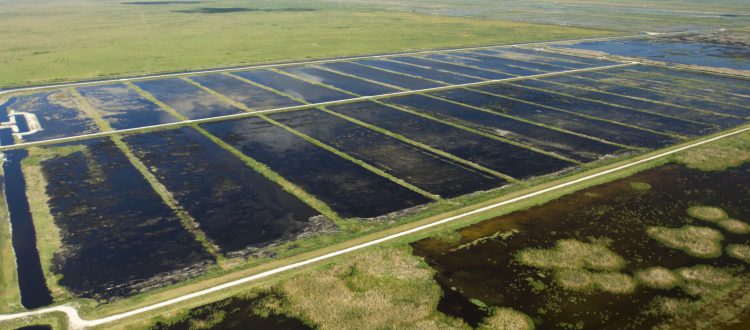
An airborne view of constructed wetlands (called Stormwater Treatment Areas) that are used to remove excess phosphorus from water before discharging into the Everglades. Photo Credit: South Florida Water Management District
Sponsor
South Florida Water Management District
Award Dates
2015 – 2018
Participants
Project Lead: K. Ramesh Reddy
Project Participants: Stefan Gerber, Patrick Inglett, Kanika Inglett, Todd Osborne, and Alan Wright
Goals and Objectives
To protect and restore the Everglades the South Florida Water Management District is working to remove excess nutrients and other pollutants, or prevent them from entering natural systems. The Everglade Stormwater Treatment Areas (STAs) are constructed wetlands that were designed to reduce excess total phosphorous from surface waters prior to discharging that water into the Everglades Protection Area (EPA). The overall goal of this project was to improve the understanding of the underlying mechanisms and factors regulating P dynamics along the hydrologic flow path, especially in the lower reaches of STAs. This goal was accomplished by a series of laboratory and field experiments and monitoring and assessment of spatial and temporal patterns of nutrients in soil and water column along flow paths of STAs. Results of this study will provide process level information on P uptake and release, and transport of mobile P across the soil/water interface, as well as movement of P within the soil profile
The study concentrated on four major objectives:
- Evaluate spatial and temporal patterns in forms and storages of phosphorus and associated elements in soils and its potential influence in regulating surface water quality. We conducted spatial and temporal soil and water sampling and monitoring of the two well performing STAs and advanced our understanding on how vegetation type, EAV and SAV, regulate forms and stability of stored phosphorus in soils.
- Evaluate the influence of flow events on surface water quality and key biogeochemical indicators. Through controlled flow events of STAs for a period of 4 to 6 weeks, we determined the interaction of vegetation and variable hydraulic and nutrient loading on outflow TP concentration. This was accomplished by collecting high spatial and temporal resolution data using autosamplers and grab samples at key locations along the flow path in STAs.
- Improve scientific understanding of the biogeochemical processes in soil and water column for management of external and internal loadings to reduce P concentrations at the outflow of STAs. We conducted a series of laboratory and field experiments to advance our understanding of the role of biological and chemical processes regulating phosphorus exchange between soil and the overlying water column. To support this effort, we identified key biogeochemical processes that can serve as indicators of STA performance in improving water quality.
- Identify and evaluate key external and internal drivers to integrate top-down and bottom-up quantitative approaches to develop management options for maximizing the efficiency of STAs. We have devised a data integration and synthesis framework that allows to link and integrate key and often disparate data across STAs. Mechanistic biogeochemical models are among the tools that help to bridge the gap between individual mechanisms and larger system behavior, as these models synthesize individual processes in order to test and predict outcomes. This forecasting ability will help to identify key internal and external drivers regulating water quality and outflow TP concentration.

